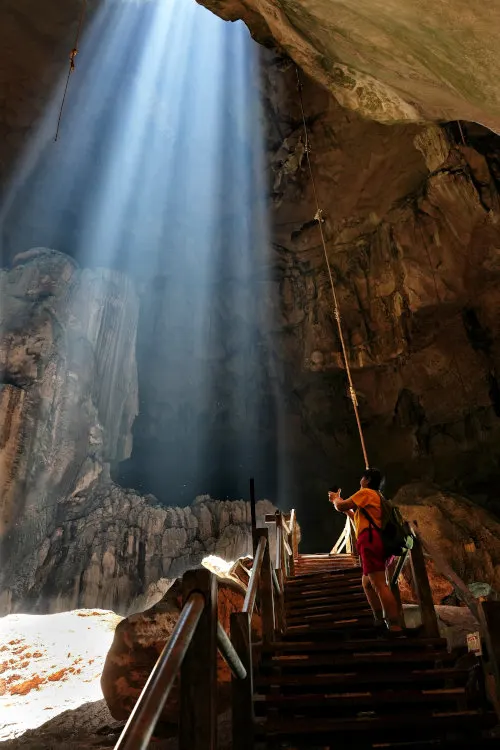
Nearly two decades ago, we visited North Sarawak once, but due to a tight schedule, we could only manage to explore Mulu Cave and Miri. We do not want to miss the opportunity again this time, so we have arranged a day trip with Brighton Travel and Tour to Niah Cave (Gua Niah) tour as part of our Northern Sarawak holiday.
Why are we so interested to visit Niah Cave? We know that Niah Cave is well known for its archaeological significance in the existence of prehistoric man in Island Southeast Asia. And since humans continuously inhabited the cave until the 19th century, there must be something worth seeing.
After a restful night’s sleep in Miri, we headed straight to Niah after breakfast. It is a leisurely drive of about an hour and twenty minutes, and we arrived at the small town of Batu Niah, approximately three kilometers from the Niah Cave.
1. Arriving at Niah National Park Office

Since now is not a holiday season, there were few visitors to the park headquarters.

We completed a simple registration process at the customer service center before taking a short walk to the jetty at Niah River.
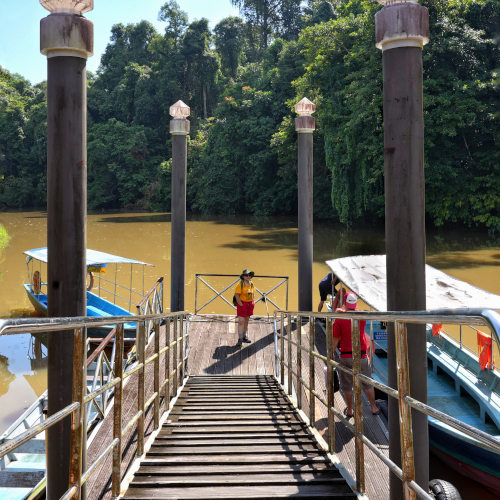
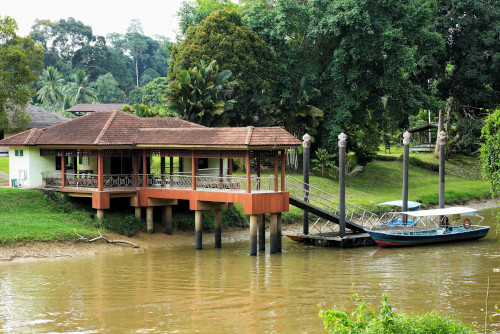
For information on the entrance fee, please refer to the image below.

Our visit included three main caves: the Traders Cave, the Great Cave, and the Painting Cave.

Accommodation options are available at the National Park, ranging from air-conditioned rooms with attached bathrooms to hostel-style rooms. If interested, please visit the national park’s website for more information.

Watch the video ot the best places to visit in Niah Cave (at the end of this article) 👇👇.
2. Some advice before the cave exploration
We are advised to bring a few things Before entering the park.
- A torchlight and spare batteries as we will need them inside the cave.
- Apply insect repellent to protect ourselves from insects.
- A bottle of drinking water to stay hydrated throughout our trip.
- Also, some personal medication and essential first aid items.
- Wear sturdy and comfortable tracking or rubber shoes.
- Lastly, get a raincoat just in case it rains.
Also, please take note of the following:
- Using the toilet before entering the cave is best, as it will be a long walk for a few hours.
- There is also a signboard to remind us to be cautious of snakes while walking on the wooden walkway, as we encountered one.
- Besides, be mindful of bees as I get stung. Although it was not poisonous, it was pretty painful.
- Furthermore, snails are in the park, so we had to watch our steps and avoid stepping on them.
3. Crossing the river

Our adventure officially began as the boatman ferried us across the river. A signboard reminded us of the crocodiles in the river, so please refrain from putting your hands in the water!
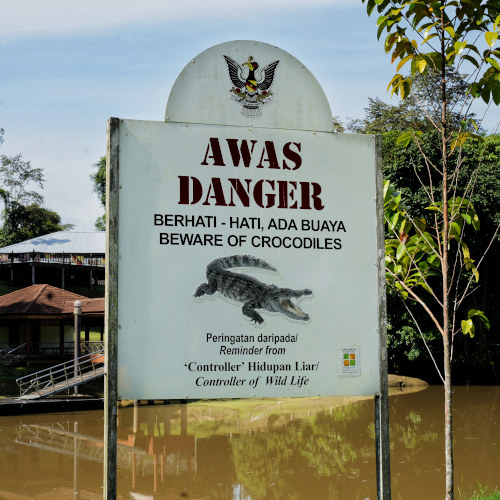
Upon entering the park, a sign indicates the distance from the entrance to the Traders Cave is approximately 2.8 kilometers.

Although it was an easy walk, it was pretty slippery due to mold growth.

There are several gazebos along the boardwalk for visitors to take a break, but we felt fresh and energetic, so we did not have any pit stops.


We encountered a pair of millipedes mating during our walk along the boardwalk, which was fascinating. It appeared they only did the act in the morning, as we no longer saw it on our return trip.


Additionally, we spotted some beautiful red ginger flowers and a hammerhead worm on the boardwalk’s railing. There are also numerous squirrels in the area.

We reached the Tangap Community Craft Center halfway to the Traders Cave. Nevertheless, we did not stop as we were eager to explore the cave.
4. The Traders Cave

Finally, we arrived at the Traders Cave, the first cave, after climbing some wooden stairs.
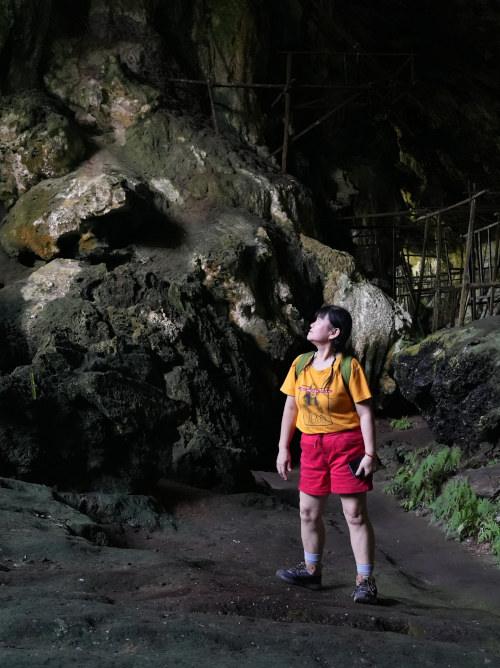
According to the sign board near the entrance, the cave was excavated in the 1950s, with only minimal archeological deposits found. The structures we saw are remains of ancient ‘roofless huts’ made of ironwood or belian. The bird nest collectors and their families constructed and used these huts as shelters during the harvesting seasons.
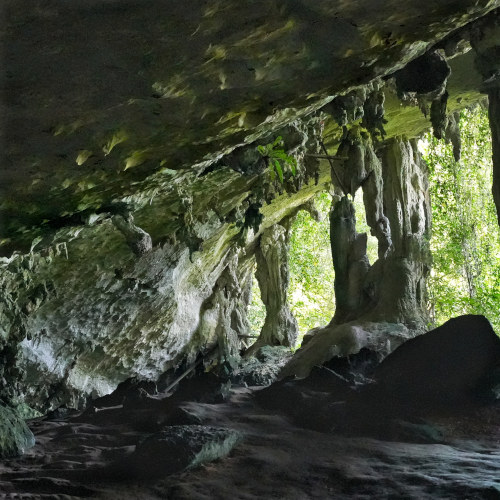
The cave is named for the collectors who sold or traded their harvests in return for products brought to the cave by traders from the towns. These huts were still used until the late 1970s.
The bird nests in this cave are the mossy type, which has no commercial value.
Also are effects of geological weathering on the walls and ceiling, made when this cave was submerged underwater million years ago.
After visiting the Traders Cave, we head towards the Great Cave, just slightly over 300 meters from here.
Booking.com5. The Great Cave

Before reaching the cave mouth of the Great Cave, we had to climb up a few flights of stairs. The fascinating sights we witnessed were the bamboo and belian (ironwood) poles to harvest the birds’ nests.
Belian (ironwood) is known for its exceptional durability, an ideal construction material. In the past, indigenous people utilized it to construct jetties, wharves, bridges, houses, coffins, and furniture. Nowadays, belian trees are protected in Sarawak, and locating them can be challenging.
We entered the Great Cave through the West Mouth, first explored by AH Everett in the 1880s. Since then, the Niah Cave Project, in collaboration with the Sarawak Museum, has conducted minor excavation activities in the caves.

This location is one of Southeast Asia’s most important archaeological sites because it provides evidence of human habitation for a long period, spanning from 40,000 to 2,000 years ago. Further, this massive cave system has an extensive collection of the oldest human remains. On February 7th, 1958, researchers discovered the earliest proof of Homo sapiens in Island SE Asia in the “Hell Trench,” located 106 to 110 inches below the original ground surface.
Bird nest collectors constructed belian and bamboo poles on the cave roof to collect bird nests. They possess mine-blowing skills to attach these poles to the cave’s ceiling.

It became pitch dark not long after we entered the Great Cave. We switched on our headlamps to navigate and found several crickets on the boardwalk.

Upon reaching the end of the cave, we were met with a vast chamber at Lubang Padang. Luckily, we arrived at the perfect time, and the rays of sunlight shone through the gaping hole in the roof, illuminating the enigmatic formation within. This spot was undoubtedly the most picturesque location during our expedition to the Niah Caves.
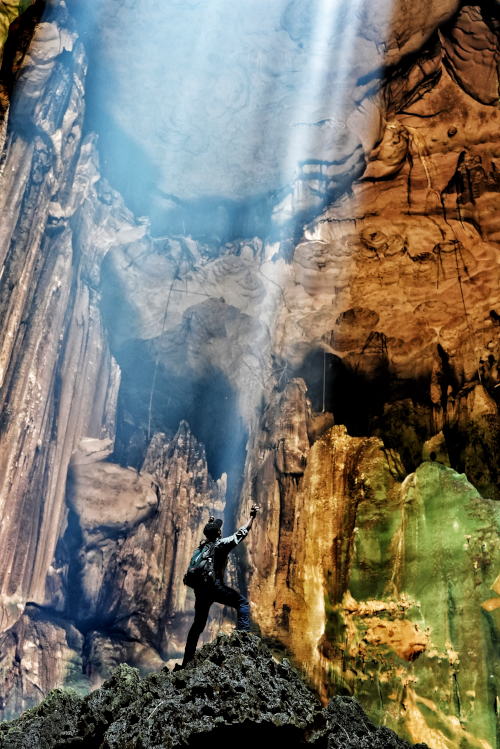
Lubang Hangus is a chamber situated in the Niah Cave. The research found that zooarchaeological records of some sections of the Niah Cave, including the Terminal Pleistocene deposits in Lubang Hangus, indicate that animal foods extensively existed. This showed that Lubang Hangus was crucial for prehistoric human habitation and subsistence.
Tom Harrison, a renowned anthropologist, ethnologist, and archaeologist, led the excavations in the West Mouth of the Niah Cave. Their most significant discovery was a human skull, known as the Deep Skull, found in deposits dating back about 40,000 years ago. This is now recognized as the earliest proof of modern humans in Borneo.
After taking some stunning photographs, we left this place and carried on to Gan Kira and Painting Cave.
6. Gan Kira

After leaving the Great Cave, we entered a stretch of cave with total darkness called Gan KIra. According to our guide, Andy, the word Gan Kira comes from Gang Kira. Kira means to count (money), and here is where the Gang of traders count their profit from collecting the bird nests.
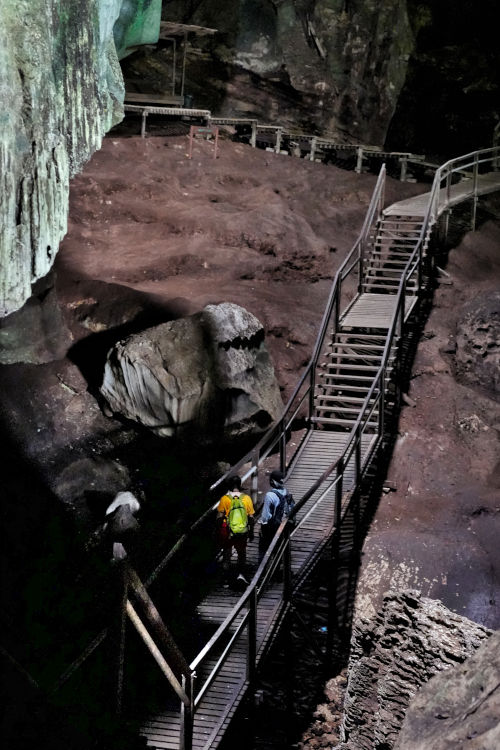
7. Painting Cave

The Painting Cave is a limestone cave about 400 meters from Gan Kira. We left the Gan Kira and walked on a boardwalk outside the cave. Painting Cave is not particularly large, but what makes it fascinating is the prehistoric ancient paintings found inside.
Archaeological excavations have uncovered artifacts such as stoneware, shells, beads, metal items, and pottery, including unique double-spouted vessels.
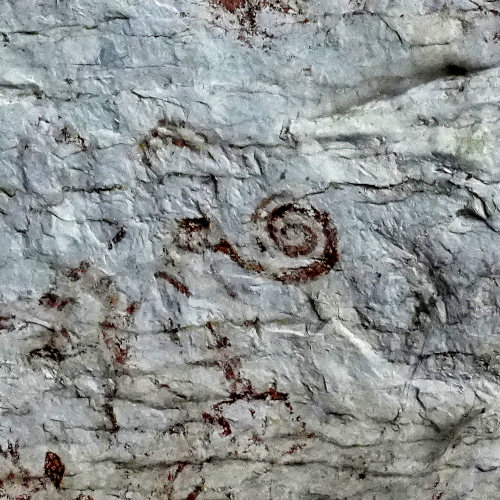


The rock art panels in the cave stretch for almost 50 meters and feature over 100 individual drawings. Each drawing is depicted in red with various sizes, from a few centimeters to one meter. It is believed that the pigment used in the drawings may be hematite or plant dye.

(The boat coffin)
Boat coffins have also been discovered in association with these finds.
The drawings depict boats, human figures, and geometric and abstract designs. These cave paintings and boats may have represented the deceased’s journey to the underworld.
Because the drawings on this painted cave are fragile and deteriorating, the site is fenced off for conservation purposes.
Below is a side-by-side comparison of photos I captured during my recent visit to a cave and a photo taken back in 1959.


8. Lunch at a longhouse in Tangap

Our journey took us through Gan Kira, and we returned to Traders Cave after exploring Painting Cave. I have included more photos we took on our way back.
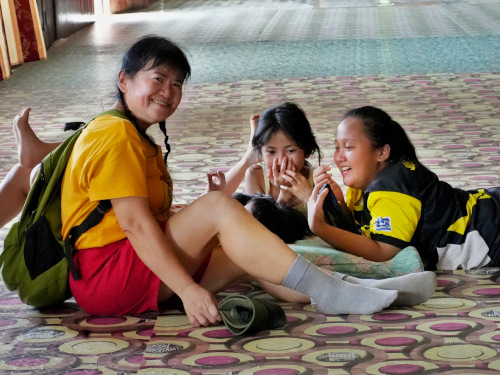
(with children in the longhouse)
We made a stop to have lunch at a longhouse in Tangap. The Iban people kindly served us traditional food. Our day concluded with a return to the National Park entrance and a dinner in Miri.

9. We stopped at Peliau Beach
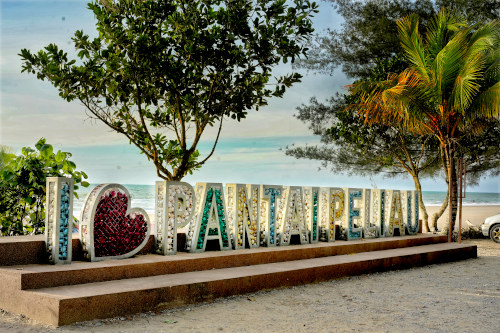
It was already past 5:00 p.m. when we started driving back to Miri. However, we felt it best to pause our journey and appreciate the sunset at Peliau Beach, halfway between Niah and Miri city.

When we arrived, two women were fishing for crabs and fish in the sea.

Our decision proved fruitful as we witnessed the beauty of the sunset at Peliau Beach.
Overall, we have explored various attractions across Malaysia in the past. Still, this experience at Niah Cave in East Malaysia was exceptional due to its prehistoric significance and magnificent cave formation. It was a day well spent. We will also plan to visit Mulu Caves during our holiday, which will be covered in a separate article.
Watch the video we shot at Niah Cave 👇👇.
We also uploaded a video of our trip to Niah Cave. Please click the image below to bring you to our YouTube channel (shot in high definition!). You may also want to check out our hiking trip to Mount Kinabalu and Miri.


James Khor
Thursday 31st of August 2023
We like to visit Sarawak, we have no time constraints, will be delighted if you can share places you visited .
kwankp
Tuesday 12th of September 2023
Sure. Please follow this link, which I have listed all my Sarawak articles here: https://travelwithlens.com/category/sarawak/ There are only a few places, but we plan to make another trip to Kuching and the surroundings in December.